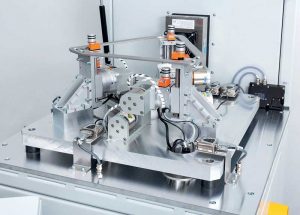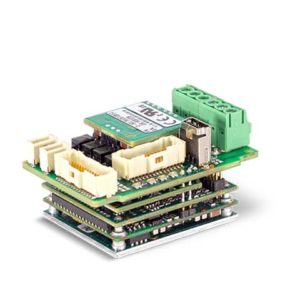Background
Stress test stations place high demands on motion control technology. During the testing, linear axes perform movement at high speed in different directions. These movements “stress” the object to determine its safety capacity against stress fractures. A typical stress test station can put the component under the stress of an entire product life cycle within a few days.
Stricter test conditions and advanced product technologies present new challenges for stress test station manufacturers. For example, in the medical industry, regulations for testing life-saving products are particularly strict, posing challenges to high-end test equipment.
Read this case study to learn about:
- How compact, high-performance servo drives can save time and resources in stress testing
- Product’s life cycle prolonged due to the drives’ high reliability

Fig.1: The stress test station from Heitec allows, among other things, test frequencies up to 1000 Hz and a repeat accuracy of <10 μm
Machine requirements
Heitec AG in Berlin develops and produces high-end testing stations that combine precision, speed and dynamics to test objects via multiaxial and dynamic application of mechanical loads. Control technology was critical for their product, since up to 600 million load cycles are included in each test run. Heitec was looking for servo drives that could drive a “clean” sine frequency with up to 1000 Hz over a short stroke of 0.01 mm to 1.5 mm. The drives had to be able to withstand medium test temperatures that can range from -10°C to 60°C, with a control accuracy of ±1°C and a measurement accuracy of 0.1°C.
Since laboratories tend to be small, Heitec wanted their stress test station to be very compact and portable—even the control panel had to be on rollers. In addition, they needed a solution that could continuously control and document test parameters such as number of cycles, test time, force, distance, frequency and temperature, and meet the relevant FDA requirements.
Motion control solution
- 6 Gold Solo Twitter servo drives
Elmo’s Gold Solo Twitter, which can be used as a standalone servo drive or in multi-axis operation, offered the perfect solution for the Heitec application. Gold Solo Twitter is tiny— measuring 47.2 x 30 x 22.15 mm weighing 60.5 g. “The test station itself is very compact with a small internal control cabinet. The small size of the Elmo Motion Control servo drives is very advantageous,” said Stephan Roth, North/East Regional Manager at Heitec AG.
Gold Solo Twitter’s low power dissipation enables installation in spaces with unfavorable heat dissipation. Depending on the cooling concept, the drive works with nominal currents of 1 A, 2.5 A, 5 A, 10 A, 15 A and 20 A. It delivers a continuous output of 1.6 kW and a peak output up to 3.2 kW. The supply voltage can vary from DC 12 V to 195 V. It also offers a certified EtherCAT or CANopen connection for real-time applications. “The servo drives from Elmo Motion Control are robustly designed and predestined for use in our test stations because they fully meet all the criteria for our application,” said Roth.
Results
Elmo’s sophisticated, compact products, such as the Gold Solo Twitter, improve performance in advanced test stations such as those produced by Heitec. “It used to take months to get a test result,” Roth concludes. “Today, thanks to modern drive technology, the tests only take a few weeks, depending on the frequency and the number of cycles.”
Gold Solo Twitter
Servo Drive, Up to 80A/80V, 70A/100V, 30A/200V
For More Information


